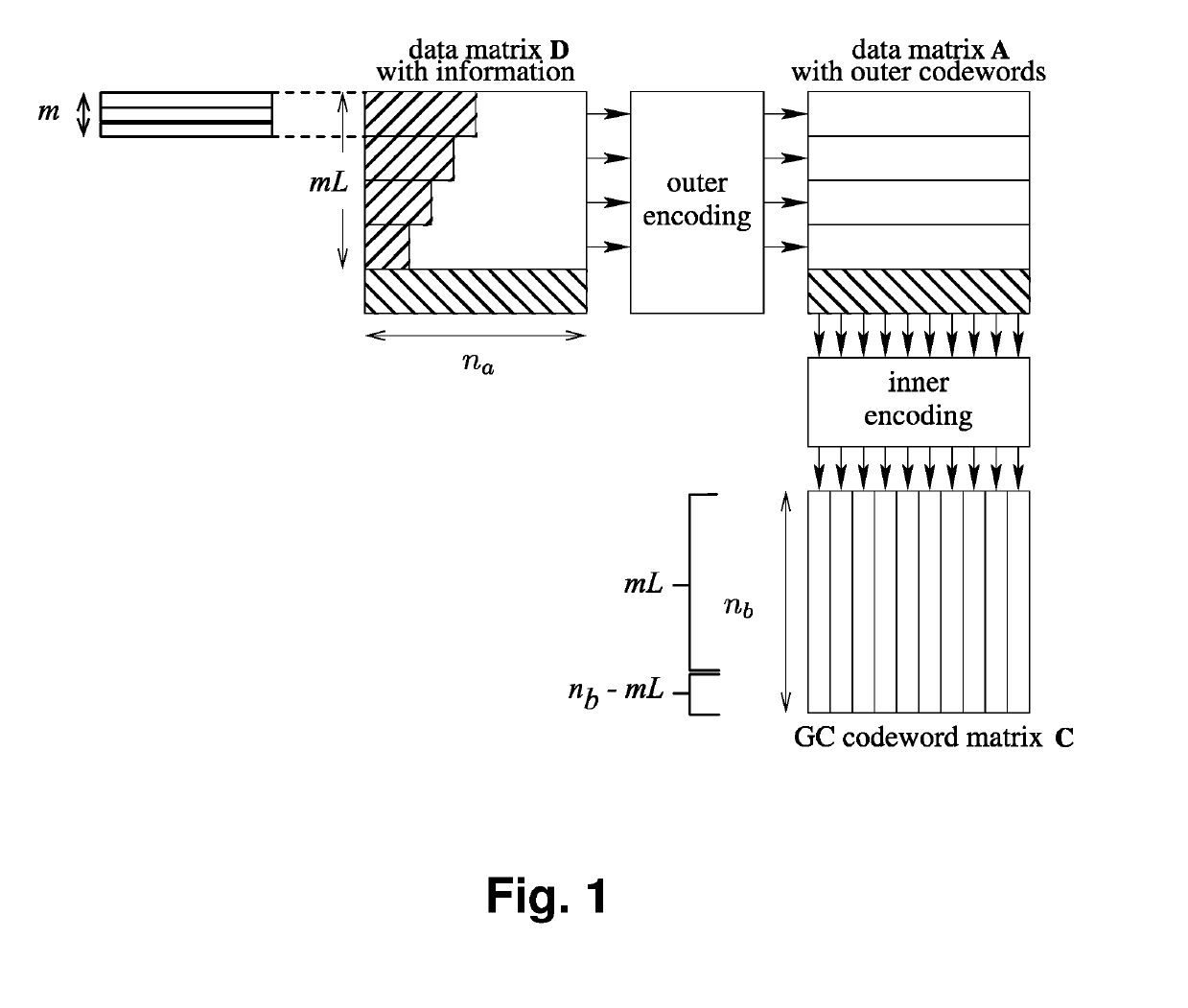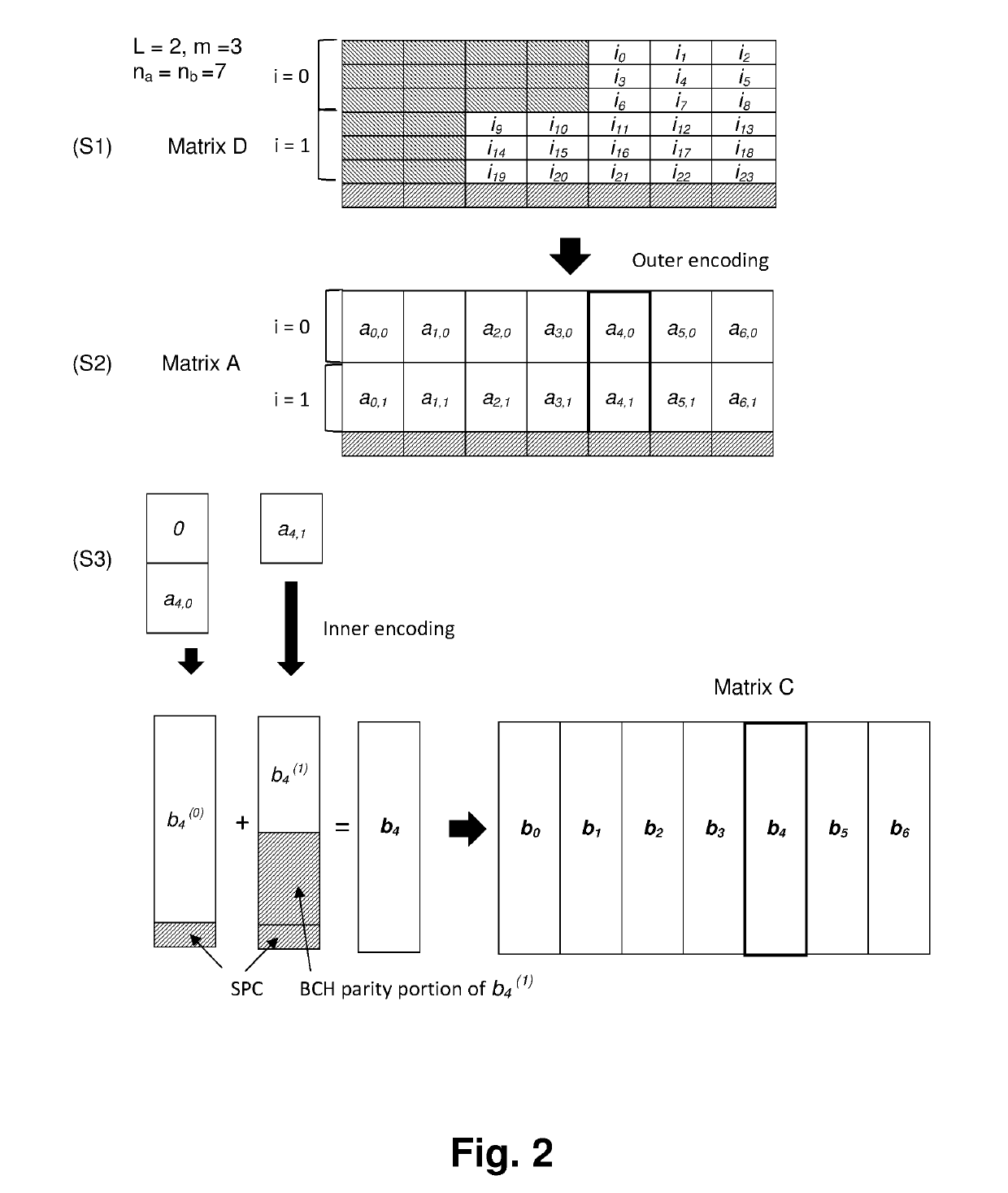Method and Decoder for Soft Input Decoding of Generalized Concatenated Codes
- Summary
- Abstract
- Description
- Claims
- Application Information
AI Technical Summary
Benefits of technology
Problems solved by technology
Method used
Image
Examples
example 3
[0096]Consider for example the code B from Example 2.
We obtain
H1=(1101)⇒B1={(0000),(1100),(1110),(0010),(1011),(1001),(1011),(0101)}
and
H2=(0111)⇒B2={(0000),(1000),(0110),(1110),(1011),(1101),(0011),(0101)},
where the underlined vectors are the codewords of the code B. The corresponding supercode trellises are depicted in FIG. 3 (b) and FIG. 3 (c), respectively.
[0097]Next the proposed sequential decoding algorithm is demonstrated. Any path stored in the stack is associated with a metric value as well as two states σt,1 and σt,2 which are the states in the trellis for supercode B1 and B2, respectively. We demonstrate decoding Algorithm 2 in the following example, where we consider the same setup as in Example 2. Algorithm 2 can be described in pseudo-code form as follows:
Algorithm 2: Sequential stack decoding using supercode trellises.Data: received word rResult: estimated codeword {circumflex over (v)}Sequential decoding starts in the nodes σ0,1 and σ0,2of the supercodetrellises;calcu...
example 4
[0098]The following table represents the stack for the received sequence r=(0010) for algorithm 2 throughout the five iterations needed to calculate the estimated codeword {circumflex over (v)}:
1st iteration2nd iteration3rd iteration4th iteration5th iterationMMMMMvt(rt|vt)vt(rt|vt)vt(rt|vt)vt(rt|vt)vt(rt|vt)00.3000.60010.9000−2.20000−1.91−2.801−2.5000−2.201−2.501−2.51−2.801−2.51−2.81−2.81−2.8
[0099]Accordingly, the top word after the 5th and last iteration is output as the estimated codeword {circumflex over (v)}=0000. A negative value indicates that the received word was in error. A positive value indicates that the received word is error free. More errors in the received word lead to a negative value with large magnitude, which indicates a low reliability of the estimated codeword. This indication can then be used by the subsequent decoding of the outer codes to correct the remaining error(s). Note that the stack in the third iteration differs from Example 2, because the code seque...
example 5
[0104]We consider three BCH codes from Table I. All codes have length n=60. In the first level, we use a single-error correcting code. This code has 3,262 nodes in the trellis. This code is a supercode of the BCH code of the second level. The trellis of the second level has 159,742 nodes. However, utilizing the trellis of the first level code, we require only a single additional supercode trellis with 2,884 nodes to represent the code at the second level. Finally, the code at the third level has a trellis with 7,079,886 nodes. Using supercode decoding, we utilize the trellises of the first and second level and require one additional supercode trellis with 2,410 nodes to represent the third code. With sequential decoding the number of visited nodes in the trellis (the number of iterations) depends on the number of transmission errors. Note that with the presented codes the time complexity with Algorithm 2 is at most 1.75 times larger than with Algorithm 1.
C. Selective Soft Input Deco...
PUM
 Login to View More
Login to View More Abstract
Description
Claims
Application Information
 Login to View More
Login to View More - R&D
- Intellectual Property
- Life Sciences
- Materials
- Tech Scout
- Unparalleled Data Quality
- Higher Quality Content
- 60% Fewer Hallucinations
Browse by: Latest US Patents, China's latest patents, Technical Efficacy Thesaurus, Application Domain, Technology Topic, Popular Technical Reports.
© 2025 PatSnap. All rights reserved.Legal|Privacy policy|Modern Slavery Act Transparency Statement|Sitemap|About US| Contact US: help@patsnap.com



